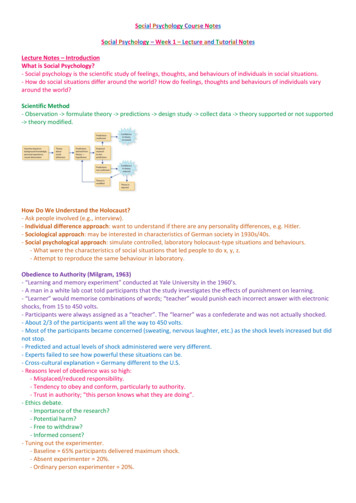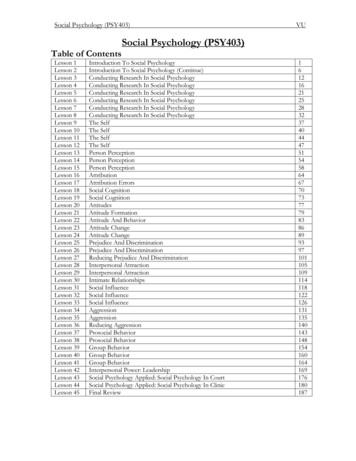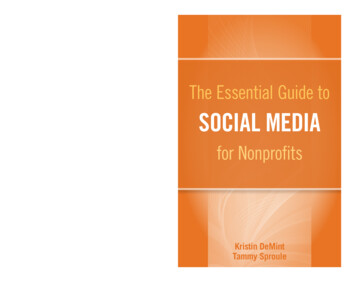
Transcription
SocialPsychology
SocialPsychologyby Daniel Richardson, PhD
Social Psychology For Dummies Published by: John Wiley & Sons, Ltd., The Atrium, Southern Gate, Chichester, www.wiley.comThis edition first published 2014 2014 John Wiley & Sons, Ltd, Chichester, West Sussex.Registered officeJohn Wiley & Sons Ltd, The Atrium, Southern Gate, Chichester, West Sussex, PO19 8SQ, United KingdomFor details of our global editorial offices, for customer services and for information about how to applyfor permission to reuse the copyright material in this book please see our website at www.wiley.com.The right of the author to be identified as the author of this work has been asserted in accordance withthe Copyright, Designs and Patents Act 1988All rights reserved. No part of this publication may be reproduced, stored in a retrieval system, or transmitted, in any form or by any means, electronic, mechanical, photocopying, recording or otherwise,except as permitted by the UK Copyright, Designs and Patents Act 1988, without the prior permission ofthe publisher.Wiley publishes in a variety of print and electronic formats and by print-on-demand. Some material includedwith standard print versions of this book may not be included in e-books or in print-on-demand. If this bookrefers to media such as a CD or DVD that is not included in the version you purchased, you may downloadthis material at http://booksupport.wiley.com. For more information about Wiley products, visitwww.wiley.com.Designations used by companies to distinguish their products are often claimed as trademarks. All brandnames and product names used in this book are trade names, service marks, trademarks or registeredtrademarks of their respective owners. The publisher is not associated with any product or vendor mentioned in this book.LIMIT OF LIABILITY/DISCLAIMER OF WARRANTY: WHILE THE PUBLISHER AND AUTHOR HAVE USEDTHEIR BEST EFFORTS IN PREPARING THIS BOOK, THEY MAKE NO REPRESENTATIONS OR WARRANTIES WITH THE RESPECT TO THE ACCURACY OR COMPLETENESS OF THE CONTENTS OF THIS BOOKAND SPECIFICALLY DISCLAIM ANY IMPLIED WARRANTIES OF MERCHANTABILITY OR FITNESS FOR APARTICULAR PURPOSE. IT IS SOLD ON THE UNDERSTANDING THAT THE PUBLISHER IS NOT ENGAGEDIN RENDERING PROFESSIONAL SERVICES AND NEITHER THE PUBLISHER NOR THE AUTHOR SHALLBE LIABLE FOR DAMAGES ARISING HEREFROM. IF PROFESSIONAL ADVICE OR OTHER EXPERT ASSISTANCE IS REQUIRED, THE SERVICES OF A COMPETENT PROFESSIONAL SHOULD BE SOUGHT.For general information on our other products and services, please contact our Customer Care Departmentwithin the U.S. at 877-762-2974, outside the U.S. at (001) 317-572-3993, or fax 317-572-4002. For technical support, please visit www.wiley.com/techsupport.For technical support, please visit www.wiley.com/techsupport.ISBN 978-1-118-77054-2 (pbk) ISBN 978-1-118-77053-5 (ebk)ISBN 978-1-118-77051-1 (ebk)Printed in Great Britain by TJ International, Padstow, Cornwall.10 9 8 7 6 5 4 3 2 1
Contents at a GlanceIntroduction. 1Part I: Getting Started with Social Psychology. 5Chapter 1: Introducing the Science of Social Psychology. 7Chapter 2: Exploring the Territory of Social Psychology. 21Chapter 3: Kitting Out: The Tools of Social Psychology. 41Part II: Understanding Attitudes and Actions. 65Chapter 4: Appraising At↜æ å titudes: The Troublesome Atoms ofSocial Psychology. 67Chapter 5: Uncovering Implicit Attitudes and Associations. 81Chapter 6: Investigating the Link between Behaviour and Attitudes. 97Part III: Thinking about Ourselves and Others. 111Chapter 7: Asking the Perennial Question: Who Am I?. 113Chapter 8: How Fantastic Am I! Looking at Self-serving Bias. 123Chapter 9: Attributing Causes to People’s Behaviour. 135Chapter 10: Making Judgements about Other People: Bias and Prejudice. 149Part IV: Comprehending Social Influence. 163Chapter 11: Appreciating the Power of the Situation. 165Chapter 12: Carrying Out Orders: Obedience. 179Chapter 13: Getting into Line: Conformity and Social Norms. 195Chapter 14: Persuading People to Part with Their Pounds. 205Part V: Assessing Relationships, Groupsand Societies. 219Chapter 15: Interpersonal Relations: Liking, Loving andLiving with Other People. 221Chapter 16: Examining the Benefits and Dangers of Social Groups . 245Chapter 17: Bridging Cross-Cultural Dif↜æ å ferences. 261Part VI: The Part of Tens. 273Chapter 18: Ten Questions for Getting the Most from Psychology Articles. 275Chapter 19: Ten Great Ways to Delve Deeper into Social Psychology. 287Index. 295
Table of ContentsIntroduction. 1About This Book. 1Foolish Assumptions. 2Icons Used in This Book. 2Beyond the Book. 3Where to Go from Here. 3Part I: Getting Started with Social Psychology. 5Chapter 1: Introducing the Science of Social Psychology . . . . . . . . . . . 7Looking Down the Social Psychologists’ Microscope. 7Rummaging through the social psychologists’ toolkit. 8Mastering the power of the experiment. 9Digging for the foundations of social psychology. 10Understanding What People Think and What Makes Them Act. 11Asking people what they think. 11Measuring what people really think. 12Predicting people’s behaviour. 12Who Am I, Who Are You and Why Did They Do That?. 13Constructing your sense of self. 13Loving yourself. 14Explaining the actions of others. 14Judging and labelling others. 15Measuring the Power of Social Forces. 15Controlled by the situation. 16Obeying authority. 16Being one of the crowd. 17Persuading and convincing. 17Living the Social Life. 18Liking, loving and respecting. 18Thinking and deciding. 18Living in different cultures. 19Looking Back Up the Microscope. 19Chapter 2: Exploring the Territory of Social Psychology. . . . . . . . . . . . 21Looking at the Disciplines that Comprise Social Psychology. 22Surveying the surveys of personality psychology. 22Entering the laboratory of cognitive psychology. 23
viiiSocial Psychology For DummiesPlaying with the gadgets of neuroscience. 25Engaging with sociology. 27Tracing the ideas of evolutionary biology. 28Social Psychology in Action. 31Asking the right questions. 31Finding answers with social psychology. 35Chapter 3: Kitting Out: The Tools of Social Psychology. . . . . . . . . . . . . 41Facing Social Psychology’s Greatest Enemy: Common Sense. 42Challenging the notion of common sense. 43Accepting that common sense can be nonsense. 44Confirming biases in social thinking. 45Entering the Fascinating World of the Social PsychologyExperiment. 46Appreciating the awesome power of the scientific method. 47Designing an experiment. 49Operationalisation: Turning concepts into thingsyou can count. 55Understanding Experiments and Statistics. 57Taking to heart experimental terminology. 58Drawing conclusions. 60Strengthening evidence. 62Recognising good and bad social experiments. 62Part II: Understanding Attitudes and Actions. 65Chapter 4: Appraising At↜æ å titudes: The Troublesome Atoms ofSocial Psychology. . . . . . . . . . . . . . . . . . . . . . . . . . . . . . . . . . . . . . . . . . . . . 67Adopting an Attitude to Attitudes. 68Discovering the three dimensions of attitudes. 69Understanding what attitudes do. 70Finding ways to measure attitudes. 71Having an Attitude Problem. 73Examining the relationship between attitudes and behaviour. 74Feeling the force . . . to be consistent. 75Looking good for the person with the clipboard:People want to be liked. 76Influencing with frames and anchors. 78Chapter 5: Uncovering Implicit Attitudes and Associations. . . . . . . . . 81Bringing Implicit Attitudes into the Light. 82Meeting the masters: Advertisers. 82Where did that come from? The origins of implicit attitudes. 83Recognising the powerful force of mere exposure. 84
Table of ContentsDo you feel lucky, punk? The reality of implicit egoism. 86Making connections: Implicit associations. 87Measuring Implicit Attitudes. 88Investigating automatic activation of behaviour. 89Trying out the Implicit Association Test (↜æ å IAT↜æ å ). 91Discovering how explicit and implicit attitudes interact. 94Chapter 6: Investigating the Link between Behaviourand Attitudes . . . . . . . . . . . . . . . . . . . . . . . . . . . . . . . . . . . . . . . . . . . . . . . . . 97Dealing with Conflicting Ideas: Cognitive Dissonance. 98Experiencing cognitive dissonance. 99Considering the consequences of insufficient justification. 102Explaining the power of fraternities. 103Justifying it all . . . for love!. 104Looking at some objections to the cognitivedissonance theory. 106Looking at Yourself: Self-Perception Theory. 107Explaining yourself to yourself. 107Seeing that rewards and punishments can backfire. 108Assessing self-perception theory. 109Part III: Thinking about Ourselves and Others. 111Chapter 7: Asking the Perennial Question: Who Am I? . . . . . . . . . . . . 113Constructing Your Sense of Self. 114Discovering how you think about your identity. 115‘We’re through the looking-glass here, people’ . 116Living through the eyes of others: Social comparison theory. 117Finding a Place in the World: Consequences of Identity. 119Identifying with others: basking in reflected glory. 119Don’t believe the stereotype hype. 120Trying hard is better than being a genius. 121Chapter 8: How Fantastic Am I! Looking at Self-serving Bias. . . . . . 123Looking at Yourself: Positive Illusions. 124Believing that you’re better than average. 124Judging yourself as better than you used to be. 126Estimating your strengths as rare but your failuresas commonplace. 126Self-handicapping: Failure isn’t your fault. 127Thinking that You’re Right Most of the Time. 128Deeming your choices to be right. 129Being sure that your beliefs are correct. 129Regarding everyone else as wrong!. 131ix
xSocial Psychology For DummiesQuestioning How Long Something Makes You Happy. 131Trusting that time really does heal. 132Shifting focus over time. 133Looking at the role of your psychological immune system. 134Chapter 9: Attributing Causes to People’s Behaviour . . . . . . . . . . . . . 135Introducing the Concept of Making Attributions. 136Understanding when you tend to make attributions. 137Deciding between a ‘bad’ person or a ‘bad’ situation. 137Falling Prey to the Fundamental Attribution Error. 138Seeing Jones and Smith’s surprising discovery. 138Revealing the FAE through experiments and experience. 140Identifying the signs of the FAE. 141Taking the simple route to explaining behaviour. 142Living with the consequences of the FAE. 143Digging Deeper into the FAE. 144Experiencing differences across the world. 144Appreciating the role of perspective. 145Noticing the actor-observer bias. 146Chapter 10: Making Judgements about Other People:Bias and Prejudice . . . . . . . . . . . . . . . . . . . . . . . . . . . . . . . . . . . . . . . . . . . 149Staring at Stereotypes and Peering at Prejudice. 150Recognising that stereotypes are just categories. 151Understanding that categorisation can become prejudice. 152Creating and Sustaining Stereotypes. 153Tracking stereotypes back to their source. 153Revealing biases in social judgements. 154Proving what you already know: Confirmation bias. 155Coming to wrong conclusions: Illusory correlations. 156Making your predictions come true: Self-fulfilling prophecies. 157Observing Stereotypes in Action. 157Pressing the ‘activate stereotype’ button. 158Taking charge of stereotypes: Automatic andcontrolled processes. 159Fooling yourself. 161Overcoming Bias and Prejudice. 162Part IV: Comprehending Social Influence. 163Chapter 11: Appreciating the Power of the Situation. . . . . . . . . . . . . . 165Seeing How Situation Influences Behaviour. 166Balancing the power of beliefs against situation. 166Interpreting the situation: Bystander intervention. 168Wearing a cloak of anonymity: Deindividuation. 170
Table of ContentsPlaying Cops and Robbers: the Stanford Prison Experiment. 171Background to the experiment. 172Preparation. 172The experiment begins. 172All too much: The experiment ends prematurely. 174Analysing the fall out. 174Analysing What Makes Someone Evil. 176Chapter 12: Carrying Out Orders: Obedience. . . . . . . . . . . . . . . . . . . . . 179Investigating Obedience. 180Obeying in the laboratory: Milgram’s experiments. 181Suggesting influences on increasing anddecreasing obedience. 186Theorising reasons for levels of obedience. 188Researching Obedience Today. 191Studying obedience in ethical ways. 192‘All together now!’. 193Chapter 13: Getting into Line: Conformity and Social Norms . . . . . . . 195Addressing the Reasons for Social Norms. 196Doing impressions: The urge to mimic. 196Getting information from others. 197Acknowledging the need to fit in. 198Getting Along: Ways People Conform. 198Absorbing other people’s opinions. 199Aligning your perception with others. 199Choosing to conform over choosing to be right. 200Facing the Costs of Non-conformity: Ostracism. 201Admitting that no one likes a real-life rebel. 203Feeling left out: The pain of ostracism. 203Chapter 14: Persuading People to Part with Their Pounds. . . . . . . . . 205Walking the Routes to Persuasion. 206Considering arguments rationally: Deep processing. 207Being swayed by appearances: Shallow processing. 207Appealing to emotions. 208Recognising the Six Principles of Persuasion. 210‘I scratch your back . . .’: The urge to reciprocate. 210‘You really know your stuff!’: Being consistent. 211Nine out of ten advertisers use social proof. 214‘What a coincidence, me too!’: The desire to be liked. 215‘Trust me and my white coat’: Responding toauthority figures. 216‘Don’t delay, call today’: Implying scarcity. 216Combating Persuasion: Resistance Isn’t Always Useless. 217xi
xiiSocial Psychology For DummiesPart V: Assessing Relationships, Groupsand Societies. 219Chapter 15: Interpersonal Relations: Liking, Loving andLiving with Other People. . . . . . . . . . . . . . . . . . . . . . . . . . . . . . . . . . . . . . 221Considering an Evolutionary Perspective on Attraction. 222Discovering Why You Like the People You Like. 223Defining a pretty face. 224Preferring averagely pretty faces. 225Choosing a mate. 226Liking people who are like you. 228Focusing on the People You Love. 229Developing types of attachment in childhood. 230Searching for the ‘gay gene’. 231Interacting elements: Exotic becomes erotic. 233Living with Others: Reciprocal Altruism. 239Co-operating with each other. 239Catching the cheaters. 240‘I Know my Place’: Power and Social Status. 242Chapter 16: Examining the Benefits and Dangers ofSocial Groups . . . . . . . . . . . . . . . . . . . . . . . . . . . . . . . . . . . . . . . . . . . . . . . 245Introducing the Desire to Separate People into Groups. 245Categorising people just for the sake of it. 246Favouring people in your group. 248Safety in numbers: Motivational approach. 249Seeing Groups in Action: Group Decision-making. 251Appreciating the wisdom of the crowds. 252Discovering how a group of clever people canmake bad decisions . 253Accepting that even experts can be stupid in a group. 254Examining the Economic Approach to Group Behaviour. 256Competing for resources. 257Increasing contact to remove conflict. 258Forcing co-operation to heal divisions. 258Chapter 17: Bridging Cross-Cultural Dif↜æ å ferences. . . . . . . . . . . . . . . . . 261Meeting the People Who Take Part in Experiments. 262Examining Western and Non-western Thinking. 264Possessing different views of the self. 264Displaying cultural differences in judgements. 266Considering perceptual differences. 268Testing the consequences of perceptual variations. 269Recognising What Cultures Have in Common. 271
Table of ContentsPart VI: The Part of Tens. 273Chapter 18: Ten Questions for Getting the Most fromPsychology Articles . . . . . . . . . . . . . . . . . . . . . . . . . . . . . . . . . . . . . . . . . . 275How Does the Result Generalise to Life Outside the Laboratory?. 276Are the Authors Really Measuring What They Claimto be Measuring?. 277Are the Researchers from a Well-regarded University?. 277How Many People Are in the Experiment?. 278Are the Participants WEIRD?. 279Does the Experiment Involve Any Demand Characteristics?. 281Was the Experimenter Blind to the Conditions?. 282What Was the Control Condition?. 283Does Common Sense Support the Conclusion?. 284Does a Simpler Explanation Exist?. 285Chapter 19: Ten Great Ways to Delve Deeper intoSocial Psychology. . . . . . . . . . . . . . . . . . . . . . . . . . . . . . . . . . . . . . . . . . . . 287Consulting Research Journals. 287Becoming a Google Scholar. 288Looking up Psychological Societies. 289Using the Social Psychology Network. 290Prejudice and Bias: Highlighting Two Useful Websites. 290Communicating via Blogs. 290Following Twitter Feeds. 292Taking Online Classes. 293Listening to TED Talks. 294Working with Wikipedia Effectively. 294Index. 295xiii
xivSocial Psychology For Dummies
IntroductionThe world is not short of advice. Self-help books, sermons, parents andcelebrities regularly dispense advice on every aspect of your social life.If you want to know how to win friends and influence people, how to capturehearts and changes minds, how to believe in yourself or doubt other people,then someone will tell you five easy steps. But social psychology, and thisbook, offers you something better than advice. It can give you insight.Social Psychology for Dummies uses the tools of science to understand whypeople behave as they do. Why they are attracted to some people, but notothers? Why they are not convinced by an elegant political argument, but arepersuaded by a celebrity endorsement. Where does prejudice comes from,and how does it influence our thoughts and actions? In this book, you will seehow experimental methods can be used to reveal the inner workings of all ofthese psychological phenomena. And yes, there is a bit of advice
Being swayed by appearances: Shallow processing . 207. Social Psychology For Dummies . Social Psychology For Dummies . Social Psychology for Dummies Social Psych










